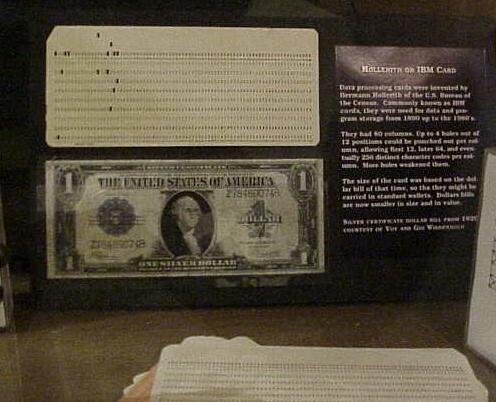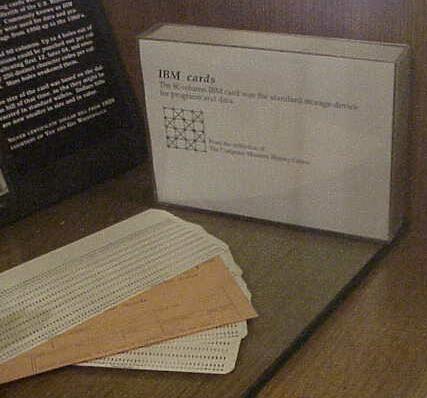 |
 |
 |
 |
 |
 |
 |
 |
 |
 |
 |
 |
The primary storage for data, and later for programs, were cards, as shown in this display. Cards were already used early in the 19th century to control Jacquard weaving looms. We have a reproduction of such cards in the display now.
Hermann Hollerith adapted the concept for data storage and processing in the 1890 census. His patented cards originally had 20 columns with 10 rows, expanded eventually to 45 columns and 12 rows. The cards had round holes, a format retained by Remington Rand, later, Sperry-Rand, subsequently Univac, and now Unisys. Initially the cards were read by having a box of pins descend, and where a hole was encountered the pins would make contact in a mercury bath below. Herman Hollerith earned a PhD from Columbia University in 1890 for his work.
Hermann Hollerith's company, the Tabulating Machine Corporation (TMC) merged with two other companies in 1911 to become the Computing-Tabulating-Recording Company (CTR), which changed its name to International Business Machines (IBM) in 1924. IBM. IBM switched to 80-column card in 1929, with square holes, which were easier to read while moving through equipment. Selling cards was a profitable business, even in 1996 boxes of 2000 cards cost over $40.-.
Adding relays and magnetic coils to the manual "Pantographic (1920)>" punches that were used to
enter data greatly reduced the data entry effort. The IBM 010 machine
in our display is from the 1930ties.
The card had 80 columns, to hold 80 digits. Punching the X-key, above
the digits, indicated minus. Later more combination were enabled for
alphabetic and punctuation characters. The Binary Card Data
Interchange Code (BCDIC) of 1931 allowed 40 characters. Coding was in
time extended - using up to 4/12 combinations, to 256 characters as EBCDIC -
including some characters not available in ASCII. More information is
provided in Prof. Douglas Jones's website.
We still find many data files in
commerce today that are 80 characters wide. Also, most early displays
were designed to show lines of 80 characters across.
Alphabetic
characters could be entered by punching the top key and a digit 1-9 in
the same columns for A-I, the X-key and 1-9 gave J-R, and 0 and 1-9
gave S-Z.
Yet later some three-punch combinations were defined
for $, ., , etc. The 8-bit codes used in the Extended
Binary-Coded-Decimal Interchange Code (EBCDIC) code for IBM-360
computers from the middle 1960ties still reflect that scheme, see the
documents on
the floor above.
For IBM's 36-bit word scientific computers, as the 704, two formats were used. The initial one. row binary used twice 36 bits across, leaving columns 73-80 free for identification and sequence numbering -- crucial if one dropped a deck of cards. These cards damaged easily if many `1's appeared on two successive words. An alternate format was `Chinese binary', where each 36-bit occupied 3 columns. Later row-binary object cards had the loading address punched in the bottom row, reducing the problems if cards got out out of order, and also enabling the making of patch cards, which would be added to the end of a deck and would overwrite errors. Since compiling of large programs took many minutes, and often required overnight scheduling, students often made such patches to their programs. Now source and object programs would no longer match, creating new challenges in debugging and program maintenance.
 |
 |
 |
 |
 |
 |
 |
 |